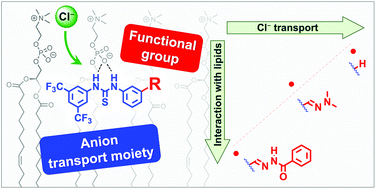Hydrazones in anion transporters: the detrimental effect of a second binding site†
Abstract
Synthetic anion transporters can be developed using anion receptors that are able to bind the anion and stabilize it in the lipophilic interior of a bilayer membrane, and they usually contain functional groups with acidic NHs, such as ureas, thioureas and squaramides. To assess the suitability of acylhydrazones as a new functional group for the preparation of anion transporters, we have studied a family of thioureas functionalized with these and related functional groups. 1H NMR titrations and DFT calculations indicate that the thioureas bearing acylhydrazone groups behave as chloride receptors with two separate binding sites, of which the acylhydrazone binds weaker than the thiourea. Chloride transport studies show that the additional binding site has a detrimental effect on thiourea-based transporters, and this phenomenon is also observed for bis(thio)ureas with two separate binding sites. We propose that the presence of a second anion binding unit hinders the transport activity of the thiourea due to additional interactions with the phospholipids of the membrane. In agreement with this hypothesis, extensive molecular dynamics simulations suggest that the molecules will tend to be positioned in the water/lipid interface, driven by the interaction of the NHs of the thiourea and of the acylhydrazone groups with the POPC polar head groups and water molecules. Moreover, the interaction energies show that the poorest transporters have indeed the strongest interactions with the membrane phospholipids, inhibiting chloride transport. This detrimental effect of additional functional groups on transport activity should be considered when designing new ion transporters, unless these groups cooperatively promote anion recognition and transmembrane transport.

- This article is part of the themed collections: #RSCPoster Conference and The Supramolecular Chemistry of Anions


 Please wait while we load your content...
Please wait while we load your content...